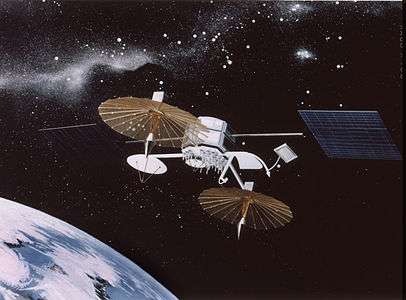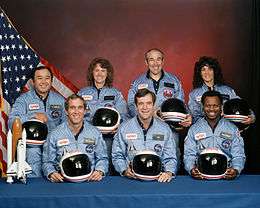TDRS-B
TDRS-B was an American communications satellite, of first generation, which was to have formed part of the Tracking and Data Relay Satellite System. It was destroyed when the Space Shuttle Challenger disintegrated 73 seconds after launch.
 Artist's impression of a TDRS satellite in orbit | |
| Mission type | Communications |
|---|---|
| Operator | NASA |
| COSPAR ID | TDRSS-B |
| Website | [] |
| Mission duration | 10 years (planned) 73 seconds (achieved) Failed to orbit |
| Spacecraft properties | |
| Bus | TDRS |
| Manufacturer | TRW |
| Launch mass | 2200 kg |
| Dimensions | 17.4 metres long 12.9 metres wide |
| Power | 1700 watts |
| Start of mission | |
| Launch date | 28 January 1986, 16:38:00 UTC |
| Rocket | Space Shuttle Challenger STS-51-L / IUS |
| Launch site | Kennedy, LC-39B |
| Contractor | Rockwell International |
| End of mission | |
| Destroyed | 28 January 1986, 16:39:13 UTC |
| Orbital parameters | |
| Reference system | Geocentric orbit |
| Regime | Geostationary orbit |
| Epoch | Planned |
Launch
TDRS-B was launched in the payload bay of Challenger, attached to an Inertial Upper Stage (IUS). It was to have been deployed from the Shuttle in low Earth orbit. The IUS would have then performed two burns to raise the satellite into a geosynchronous orbit. On the previous TDRS launch, TDRS-1, the IUS second-stage motor malfunctioned following the first-stage burn, resulting in a loss of control, and delivery of the satellite into an incorrect orbit.
Launch failed

TDRS-B was originally scheduled for launch on STS-12 in March 1984, however it was delayed and the flight cancelled following the IUS failure on TDRS-1.[1] It was later re-manifested on STS-51-E, however this too was cancelled due to concerns over the reliability of the IUS. It was eventually assigned to STS-51-L, which was to also carry the SPARTAN-Halley astronomy satellite.[2]
STS-51-L launched with TDRS-B at 16:38:00 UTC on 28 January 1986.[3] The Shuttle disintegrated 73 seconds after launch due to an O-ring failure in one of the Solid Rocket Boosters, killing the seven astronauts aboard.
Aftermath
_-_GPN-2004-00007.jpg)
Once it reached orbit, TDRS-B was to have been given the operational designation TDRS-2. Although normal practice was to reassign operational designations in the event of launch failures, the TDRS-2 designation was not reassigned, and when TDRS-C was launched, it became TDRS-3. Debris from TDRS-B was recovered along with the wreckage of Challenger
The TDRS-G satellite was ordered to replace TDRS-B.[4] It was launched from Space Shuttle Discovery in 1995, on mission STS-70. It became TDRS-7 after reaching geosynchronous orbit.[3]
References
- Wade, Mark. "STS-12". Encyclopedia Astronautica. Retrieved 24 June 2009.
- Krebs, Gunter. "TDRS 1, 2, 3, 4, 5, 6". Gunter's Space Page. Retrieved 25 June 2009.
- McDowell, Jonathan. "Launch Log". Jonathan's Space Page. Retrieved 24 June 2009.
- "Tracking and Data Relay Satellite System (TDRSS)". NASA Space Communications. Retrieved 25 June 2009.


